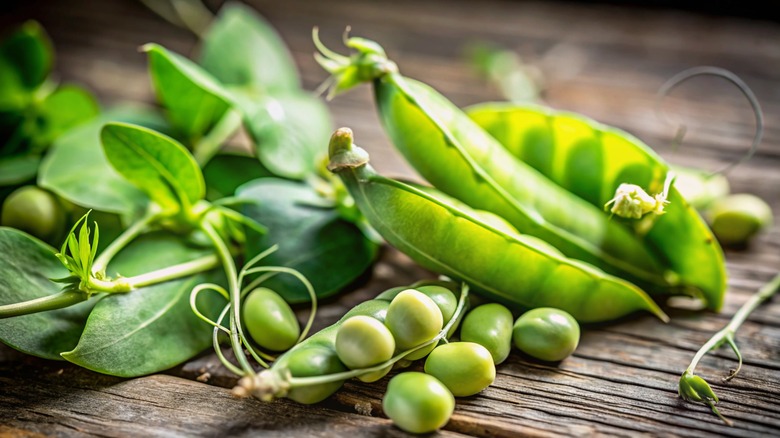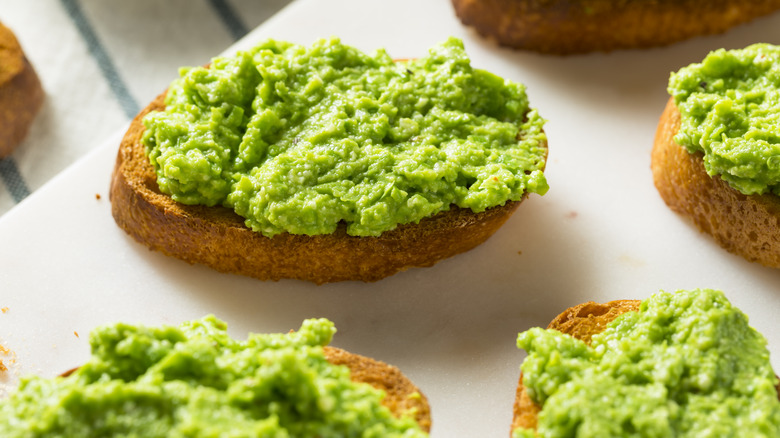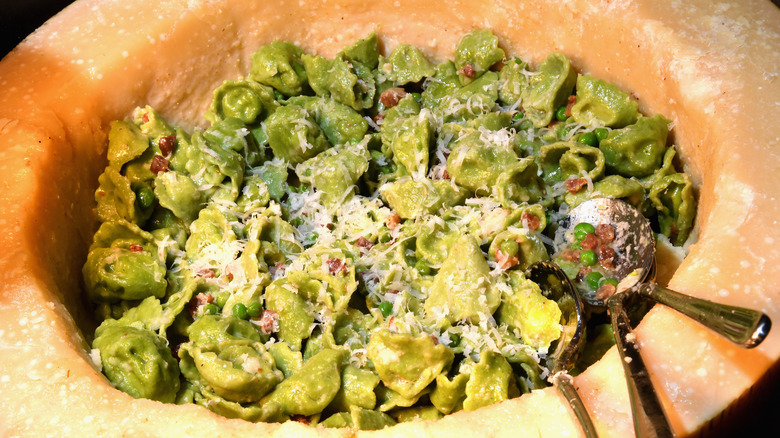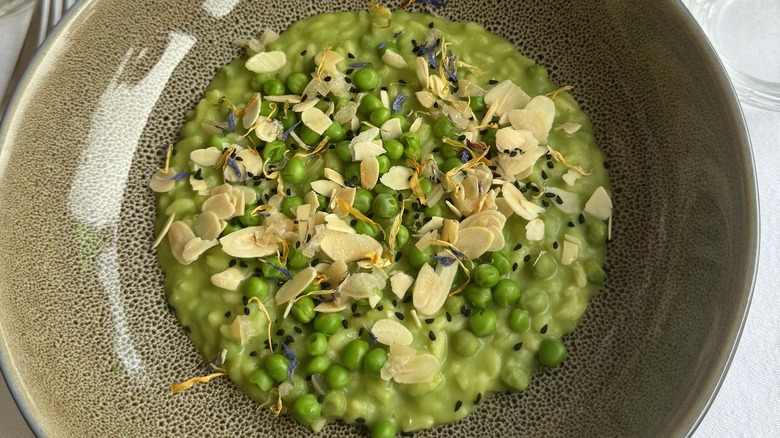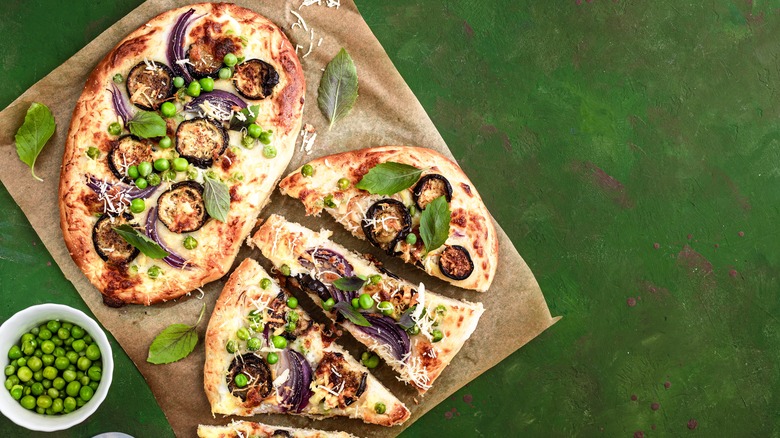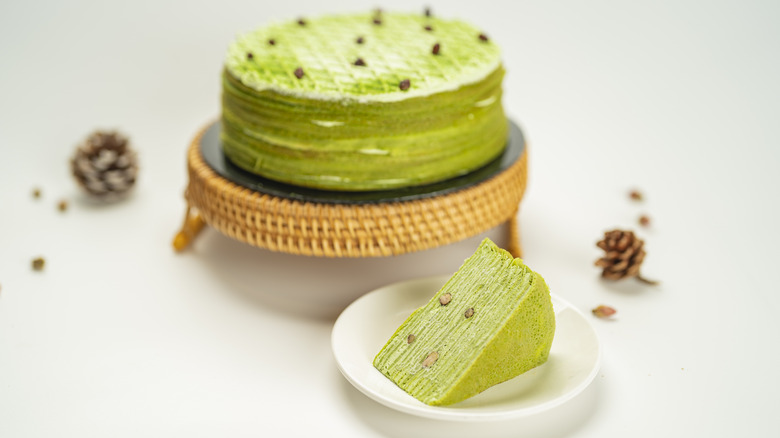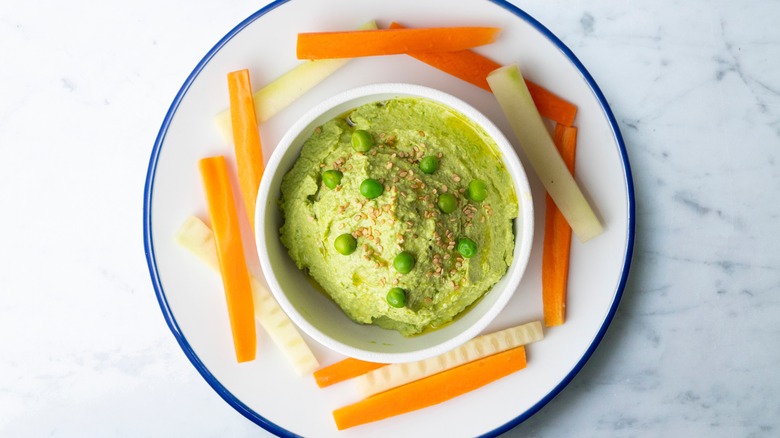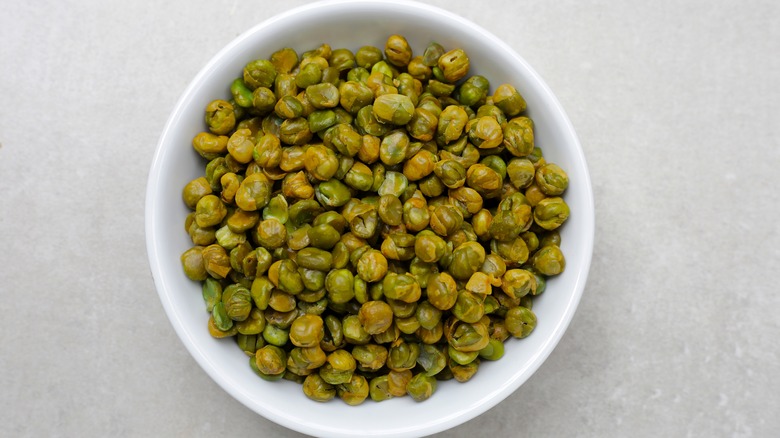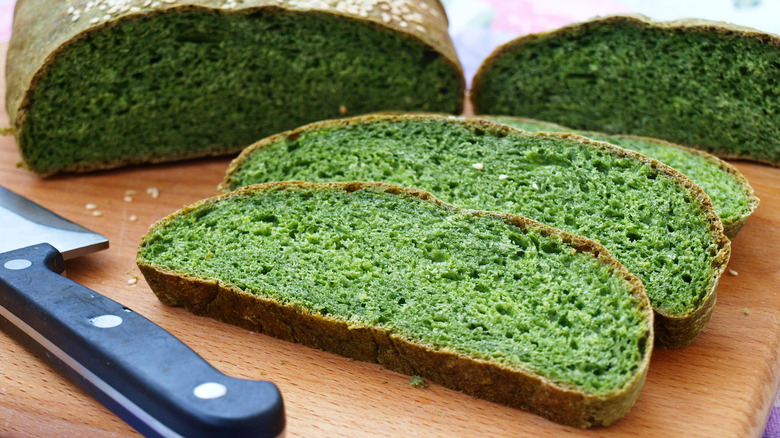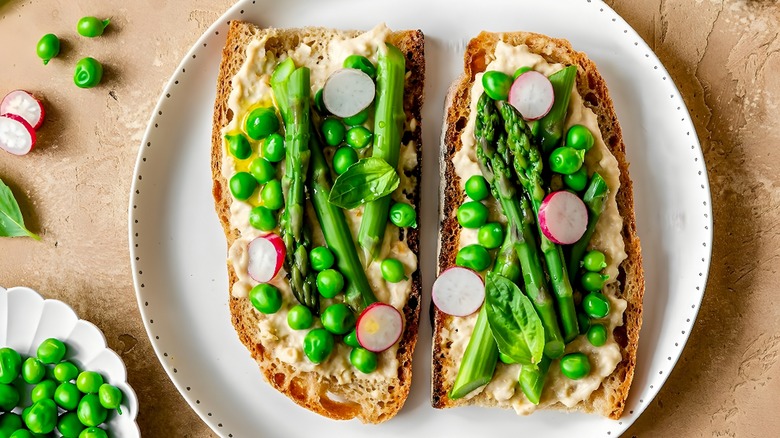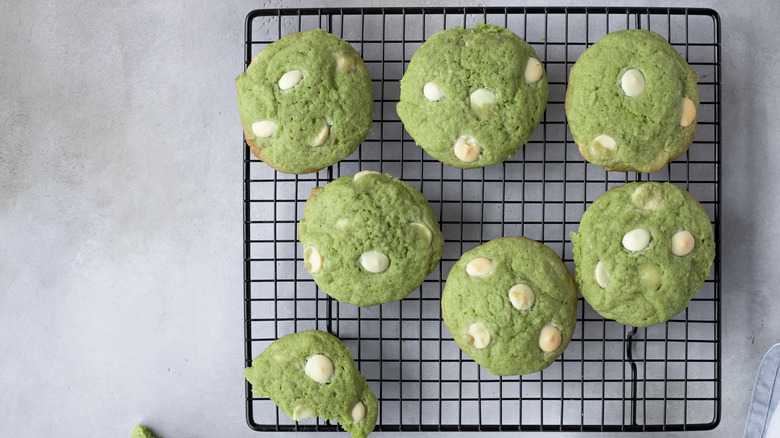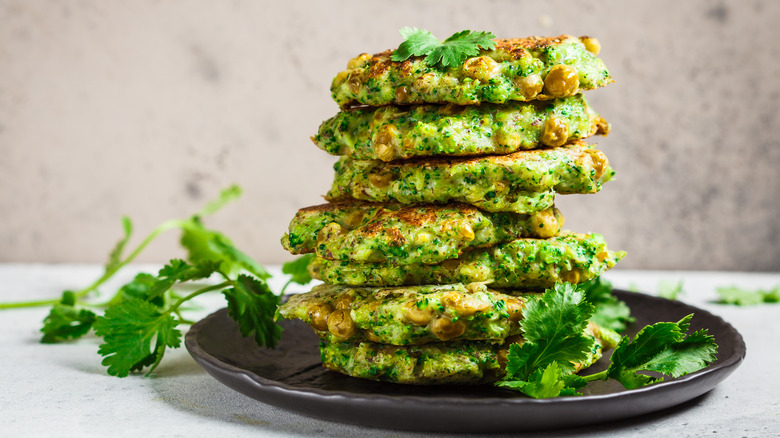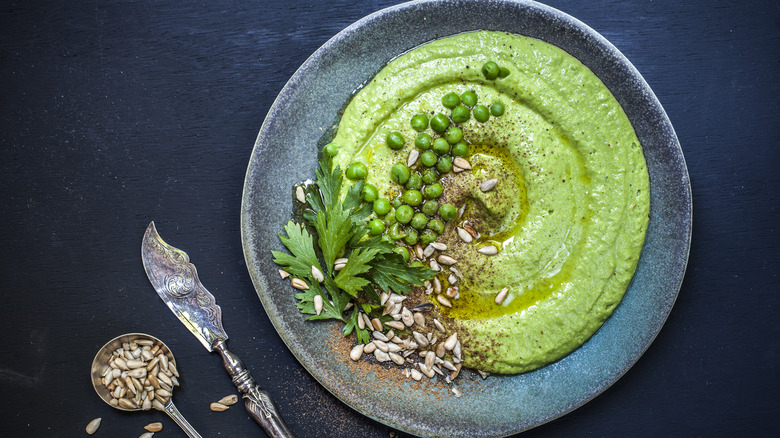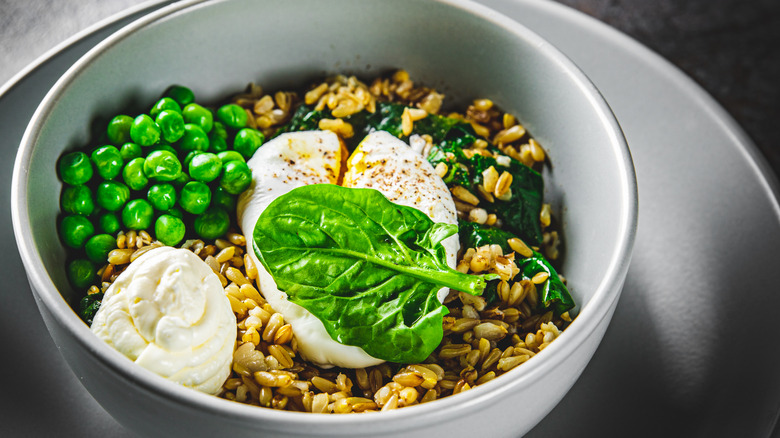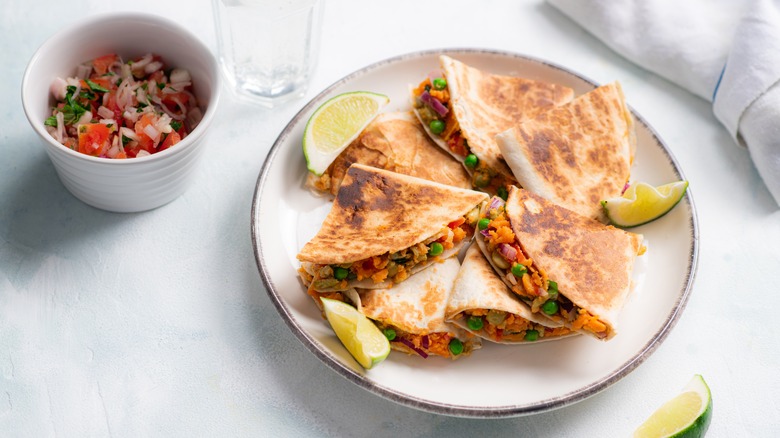14 Unexpected Ways To Use Peas
Peas aren't the most glamorous of ingredients. These little legumes are usually found shoved in the back of a freezer drawer, overlooked and only brought out when you're looking for something quick, easy, and green to use as a side. But it doesn't have to be this way — there are so many amazing ways to cook peas, some of them quite surprising.
Packed with protein, fiber, and a range of vitamins and minerals, we should all be eating more peas. But, they're not just nutritious but amazingly tasty too, especially when you season them right and know what ingredients to pair them with. Some of my favorite lesser-known ways to use peas bring them to the forefront, highlighting their fresh, sweet flavor. Others seek to hide peas so you'd never know they were there. I'm looking at you pea cookies.
As an experienced food writer, recipe developer, and cook, I'm more passionate about peas than the next guy. If you get me talking about food, I will spend 10 minutes waxing lyrical about pea and mint pesto. I'm sorry but you've been warned. That might not make me the most interesting person to chat to at a party, but it does mean I'm the right person to write about some of the most unexpected ways to use peas. Buckle up.
Smashed on toast
If there's anyone who should be the PR person for smashed peas on toast, it's me. It's one of my go-to choices at my favorite brunch spots and I'll make it at home for breakfast, lunch, or dinner — sometimes more than one of those meals on the same day. Does it sound appealing? Not really. But try it and you'll understand why I want to waffle on about it for 200 words.
Smashed peas are delicious slathered onto thick slices of sourdough. You can get creative with the toppings, but crumbled feta, chili flakes, pickled red onions, fresh herbs, and pesto are all good options. It's a dish that's easy to adapt to your preferences.
When they're described as smashed peas, there's some creative license there. Peas don't really mash or smash and you want a relatively smooth consistency for this dish so using a blender or food processor is the way to go. You just pulse your peas — fresh and podded or frozen and defrosted — until they reach a paste-like consistency. Some chunks are fine but not too many whole peas. When you blend them, add your choice of seasonings and aromatics. Garlic, lemon juice, and fresh herbs are my jam.
Blitzed into pesto
Classic pesto consists of pine nuts, basil, Parmesan, and olive oil. It's great, but there's room in this world for more than one kind of pesto and I'm not one to follow tradition for no good reason. Pea pesto is a great alternative and one I rave about just as much as smashed peas.
There's plenty of room to experiment with it. Some recipes follow the rules of classic pesto with some changes. For instance, recipes might contain basil, pine nuts and garlic but use peas in place of the cheese. This gives it a familiar flavor profile but with a twist. However, other recipes use mint in place of the basil and yet more forgo the pine nuts altogether.
What most recipes have in common is that they use less oil than traditional pesto and have a thicker, scoopable consistency. I love pea pesto stirred through pasta. It has a fresh flavor that's great for spring and summer — although, of course, you can enjoy it year-round. It's also delicious anywhere you might eat conventional pesto. For instance, in sandwiches, on crostini, mixed into omelets, or used as a salad dressing — and that's just for starters.
In a risotto
If you haven't thought to use peas in risotto, you're missing out. It's not especially unexpected in Italian cuisine — my nonna makes a mean risotto con piselli (aka peas) — but it hasn't made its way to the U.S. in such a big way. You might think that you need fancy ingredients to make great risotto. When, actually, you can use everyday produce like peas to whip up some of the best versions you've ever tasted.
Like all risottos, you start by sautéing plenty of onion. This provides a flavorful base for the dish. Then, you gradually add stock to the dish until it's reached the right consistency. It should be loose and soupy, not thick or claggy. At this point, you add peas and let the heat of the dish warm them through. Some recipes also call for pea purée to be added at this point.
But, if standing over a hot stove stirring risotto constantly isn't your idea of fun, I get it. You might want to check out this Instant Pot risotto recipe featuring peas. You still get a great risotto but with much less hands-on cooking time.
As a pizza topping
Did you know that green peas are a popular pizza topping in Brazil? I'm a huge pizza fan. I even used to make it professionally. And I'm always into trying new and unexpected toppings but this was news to me. It might be a bit left of field but millions of Brazilians can't be wrong, so it's something worth trying.
The trend for peas on pizza might come from the fact that many Italian immigrants moved to Brazil. There are roughly 25 million Brazilians with Italian heritage, so pizza is a big deal in the country. But, why peas? Well, these legumes are popular in Brazilian cuisine, so them being eaten on pizza is likely a case of the merging of food cultures.
You can find peas on many veggie pizzas in Brazil, among more classic toppings like bell peppers, olives, and zucchini. However, there are also Brazilian pizzas that combine peas with hard-boiled eggs or with prosciutto and sunny-side up eggs.
Blended into a cake
If you think I've gone a step too far by suggesting peas belong in cake, I hear your reservations. But, approach it with an open mind. Here at Mashed, we've explored the canned vegetables that make delicious cakes – and peas are among them. But, you don't have to use canned peas. In fact, many recipes use fresh or frozen peas.
These legumes are blended into a purée before being mixed into cake batter. This also turns the sponge bright green, which is pretty fun. It's not a case of whizzing them into the batter and not tasting them — you absolutely can. They bring a sweet earthiness to the cake. However, ingredients like sugar and vanilla extract soften them.
Done right, the cake should be well-balanced and delicious. Then, there's frosting. Plain vanilla works well, as does lemon frosting or cream cheese frosting, both of which bring tanginess and brightness. Still not convinced? Think about the other veggies that are regularly used in cake — carrots, zucchini, and even beets. So, let's give peas a chance.
Turned into hummus
You might think the perfect hummus contains not much more than chickpeas, tahini, garlic, and lemon juice. But, have you ever heard of pea hummus? It's super simple to make and it pairs well with a range of dishes so it's one you'll want to add to your repertoire if you want a change from conventional hummus.
If you're made the regular stuff before, then you already know how to make the pea version. You can use your favorite hummus recipe but replace the chickpeas with fresh or defrosted frozen peas. Both ingredients work basically the same because they're legumes. Essentially, the recipe involves blending together garlic, lemon juice, tahini, peas, a little liquid (water or oil), and seasoning. You can adapt it by adding fresh herbs. Most soft ones work — parsley, dill, or cilantro are my faves.
I love the fresh flavor of pea hummus. It's great in sandwiches, spooned onto salads, or as a dip for chips or vegetable sticks. The flavor is much like what I imagine hummus would be like made with fresh green chickpeas, were they more readily available. To serve, drizzle it with extra-virgin olive oil and sprinkle it with cumin, smoked paprika, or fresh herbs.
Roasted as a snack
Who doesn't love a snack? But the same ones can get boring after a while. Chips, fruit, cookies, carrot sticks — been there, eaten that. Another unexpected way to use peas is to simply roast them and eat them by the handful. The resulting legumes are sweet, slightly crispy, and totally delicious. Because they're rich in protein, they're also filling and will keep you going until your next meal.
It's incredibly easy to roast peas. Start by preheating your oven to 360 degrees Fahrenheit. If you're using frozen peas, you'll also need to defrost them. The easiest way to do so is to stick them in a colander under running water. After you're done, dry them off using a tea towel — if they go in the oven too wet, they won't get crispy. Lay your peas on a baking sheet in a single layer. Drizzle over some oil and sprinkle on some salt, tossing them to coat. Then, roast them for 15 to 20 minutes, shaking the pan every few minutes.
If they're not too brown at the 20-minute mark, you can roast them for up to an extra 10 minutes to get them crispier. Finally, let them cool and then they're ready to eat. You also have the option to add spices and other seasonings along with the salt — use your imagination.
Baked into bread
Pea bread might not sound too appetizing — especially when you say it out loud. But, it's an easy way to a moist and chewy loaf. It's essentially like a legume version of a potato bread recipe. In the finished loaf, you'll get a bit of a green tint but you don't particularly taste peas. As a pea-lover, this isn't necessarily a draw for me, but it's good if you're trying to get more nutrients in your bread without affecting the flavor. Plus you could absolutely increase the pea content to taste it more.
Some recipes use canned peas. These are softer than fresh or frozen ones so you can just knead them whole into the dough if you're using a stand mixer or bread machine. The kneading will break the peas down — you won't be left with any whole ones in the finished loaf. Alternatively, you can blend your peas into a purée before adding them to the dough mixture. This is your best bet if you're using defrosted or fresh peas.
Eaten in a sandwich
I'm always looking for new ingredients to put in sandwiches. Bonus points if they're filling and nutritious. It took me a while to even consider peas as an option but once I did there was no going back. They bring freshness and loads of flavor. Plus, they're more versatile than you think, working with a range of different flavors.
One option is to use the pea hummus or pea pesto mentioned earlier as a sandwich filling. They're thick enough to work as a filling in their own right — they won't just spill out of the sandwich if you put a hefty layer inside — but they also work as condiments. They pair with a range of ingredients, such as arugula, grated carrots, roasted veggies, chickpeas, or tofu.
However, you can use whole peas in a sandwich as well, as long as you have ingredients that will hold them inside the sandwich, like a kind of glue. They're perfect in grilled cheese, since the melted cheese will keep them in place. They also work well with spiced mashed potatoes, as a samosa-like filling. However you decide to use peas in your sandwich, it's an unconventional yet tasty choice.
Added to cookie recipes
Cake isn't the only sweet option for using peas. They're also great in cookies. Clearly they don't sound all that appetizing, but you'd be surprised. And, like many things in life, the only way to find out if you like it is to give it a try.
You can make chocolate chip versions, with peas blended into the dough and chunks or chips of chocolate mixed through. Or there are double chocolate options, with peas and cocoa powder in the dough and chocolate chunks or chips. You could experiment with other flavors, as well, but chocolate is always a winner and it goes with the sweet yet vegetal flavor of peas.
You don't want any lumps of whole peas, so you'll need to blend them thoroughly before adding them to the dough. But, that aside, the process of making them is much the same as any other cookie. You can taste the peas, but it adds something pleasant rather than making the cookies worse. It's a good way to sneak something green into picky kids' diets, too.
Mixed into fritters
Few things can't be improved with frying. Peas are certainly no exception. I'll make fritters out of just about any vegetable but peas are up there with the best. I love the little pops of freshness amongst the heartiness of the rest of the fritter. You can experiment with different flours for the batter with great results.
There are all kinds of ways to make pea fritters. Some use a mixture of peas and other legumes, others just peas. Some keep the peas whole, others mash or blend them. Then you have the chip shop pea fritter, which is a whole other beast. This British classic consists of mushy peas inside a thick yet crispy batter. It's delicious and something everyone should try at least once.
While most fritter recipes call for regular wheat flour, I love the flavor of chickpea flour. It's the same flour used in onion bhajis so it goes well with spices. You could also experiment with other alternatives to wheat flour, though some work better as binders than others.
Whizzed up into a dip
You can easily turn peas into a tasty dip that's perfect as a simple snack but feels fancy enough to serve to guests or bring to a gathering. Peas blend beautifully into a creamy spread with just a few ingredients, plus their natural sweetness means it's difficult to make them taste bad.
You can use defrosted or fresh peas for a dip, blending them with various ingredients depending on your preferences. Try adding a squeeze of lemon for tang and brightness or a drizzle of olive oil for richness. Fresh herbs like mint, basil, or parsley are always a welcome addition, while a hint of garlic brings extra flavor and a sprinkle of chili flakes is great if you like some spice. You might want to blend in some feta or cream cheese to make it tangier and creamier.
This vibrant green dip works wonderfully with all kinds of accompaniments. Scoop it up with pita chips or raw veggies like carrots, bell peppers, and cucumber. It also makes a tasty spread for toast or crackers. It's a versatile choice that's easy to adapt — and is full of goodness too.
Cooked in savory oatmeal
Some people say we should all be eating savory oatmeal for breakfast. I haven't always been a fan, preferring the sweet version, but if anything can win me over it's peas. So, consider me a savory oatmeal convert. It's quick and easy to make and fills you up without leaving you prone to a sugar crash the way that sweet breakfast foods can.
The beauty of using peas in savory oatmeal is that they cook quickly, so you can simply add them to the oats while they're simmering. There's no need to cook the peas separately beforehand like there is with other produce. They also add protein to the meal, which helps you to stay feeling fuller for longer meaning you won't crash before lunchtime.
The key to good savory oatmeal is packing plenty of flavor in there. You can use all kinds of herbs and spices. Lemon juice is a nice addition at the end of cooking to add some brightness. And cheese never goes amiss.
In quesadillas
Peas in a quesadilla? It might sound weird, but I'm so here for it. Their natural sweetness and creamy texture when blended make them a perfect filling. Peas play well with all kinds of flavors, so you can get creative with your quesadilla ingredients. Try mixing them with chopped herbs like cilantro or green onions for more flavor or add a little chili powder for a kick.
When it comes to cheese, you have loads of options. Mild, melty cheeses like mozzarella or Monterey Jack work great, so peas can keep the starring role. For a stronger taste, feta or sharp cheddar contrasts the peas' sweetness. You can throw in some extras like corn, diced bell peppers, black beans, or spinach.
Cooking up pea-filled quesadillas is quick and easy. However, the key to making the best quesadillas at home is using homemade tortillas — so it'll take you a bit longer if you choose to do that. It's a nice way to get more nutrients in your quesadillas, and to mix things up compared to the same old flavors you normally use.
